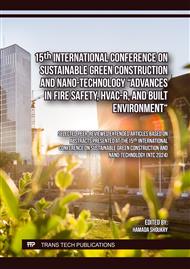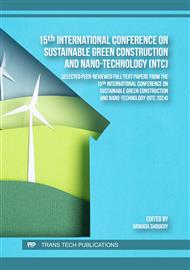[1]
M. F. Junaid, Z. ur Rehman, M. Kuruc, I. Medveď, D. Bačinskas, J. Čurpek, M. Čekon, N. Ijaz, W. S. Ansari, Lightweight concrete from a perspective of sustainable reuse of waste byproducts, Construction and Building Materials 319 (2022) 126061. .
DOI: 10.1016/j.conbuildmat.2021.126061
Google Scholar
[2]
S. H. Helmy, A. M. Tahwia, M. G. Mahdy, M. Abd Elrahman, Development and characterization of sustainable concrete incorporating a high volume of industrial waste materials, Construction and Building Materials 365 (2023) 130160.
DOI: 10.1016/j.conbuildmat.2022.130160
Google Scholar
[3]
M. M. Atyia, M. G. Mahdy, M. Abd Elrahman, Production and properties of lightweight concrete incorporating recycled waste crushed clay bricks, Construction and Building Materials 304 (2021) 124655.
DOI: 10.1016/j.conbuildmat.2021.124655
Google Scholar
[4]
W.M. Shaban, K. Elbaz, M. Amin, A. G. Ashour, A new systematic firefly algorithm for forecasting the durability of reinforced recycled aggregate concrete, Frontiers of Structural and Civil Engineering 16.3 (2022) 329-346.
DOI: 10.1007/s11709-022-0801-9
Google Scholar
[5]
I.Y. Hakeem, M. Amin, I.S. Agwa, M.H. Abd-Elrahman, M.F. Abdelmagied, Using a combination of industrial and agricultural wastes to manufacture sustainable ultra-high-performance concrete, Case Studies in Construction Materials 19 (2023) e02323.
DOI: 10.1016/j.cscm.2023.e02323
Google Scholar
[6]
M. Abdellatief, W. E. Elemam, H. Alanazi, A. M. Tahwia, Production and optimization of sustainable cement brick incorporating clay brick wastes using response surface method, Ceramics International 49.6 (2023) 9395-9411.
DOI: 10.1016/j.ceramint.2022.11.144
Google Scholar
[7]
I.Y. Hakeem, M. Alharthai, M. Amin, A.M. Zeyad, B.A. Tayeh, I.S. Agwa, Properties of sustainable high-strength concrete containing large quantities of industrial wastes, nanosilica and recycled aggregates, Journal of Materials Research and Technology 24 (2023) 7444-7461.
DOI: 10.1016/j.jmrt.2023.05.050
Google Scholar
[8]
S.H. Helmy, A.M. Tahwia, M.G. Mahdy, M. Abd Elrahman, M.A. Abed, O. Youssf, The Use of Recycled Tire Rubber, Crushed Glass, and Crushed Clay Brick in Lightweight Concrete Production: A Review, Sustainability 15.13 (2023) 10060
DOI: 10.3390/su151310060
Google Scholar
[9]
J. Ahmad, A. Majdi, A. Babeker Elhag, A. F. Deifalla, M. Soomro, H. F. Isleem, S. Qaidi, A step towards sustainable concrete with substitution of plastic waste in concrete: Overview on mechanical, durability and microstructure analysis, Crystals 12.7 (2022): 944.
DOI: 10.3390/cryst12070944
Google Scholar
[10]
Y. C. Ersan, S. Gulcimen, T. N. Imis, O. Saygin, N. Uzal, Life cycle assessment of lightweight concrete containing recycled plastics and fly ash, European Journal of Environmental and Civil Engineering 26.7 (2022) 2722-2735.
DOI: 10.1080/19648189.2020.1767216
Google Scholar
[11]
A.J. Babafemi, B. Šavija, S.C. Paul, V. Anggraini, Engineering properties of concrete with waste recycled plastic: A review, Sustainability 10.11 (2018) 3875.
DOI: 10.3390/su10113875
Google Scholar
[12]
EN 206-1; European Standard, Concrete—Part 1: Specification, Performance, Production and Conformity. 2001. Available online: https://standards.iteh.ai/catalog/standards/cen/af40b93d-23eb-43ae-8880-d6b6c9088325/en-206-1-2000 (accessed on 10 May 2023).
Google Scholar
[13]
J.H. Mohammed, A.J. Hamad, Materials, properties and application review of Lightweight concrete, Technical Review of the Faculty of Engineering University of Zulia 37.2(2014)10-15.
Google Scholar
[14]
M. Aslam, P. Shafigh, M. Z. Jumaat, Oil-palm by-products as lightweight aggregate in concrete mixture: a review, Journal of cleaner production 126 (2016) 56-73.
DOI: 10.1016/j.jclepro.2016.03.100
Google Scholar
[15]
D.J.M. Flower, J.G. Sanjayan, Green house gas emissions due to concrete manufacture, The international Journal of life cycle assessment 12 (2007) 282-288.
DOI: 10.1007/s11367-007-0327-3
Google Scholar
[16]
N.K. Bui, T. Satomi, H. Takahashi, Recycling woven plastic sack waste and PET bottle waste as fiber in recycled aggregate concrete: An experimental study, Waste management 78 (2018) 79-93.
DOI: 10.1016/j.wasman.2018.05.035
Google Scholar
[17]
H. Al-Kroom, M. M. Atyia, M. G. Mahdy, M. Abd Elrahman, The effect of finely-grinded crushed brick powder on physical and microstructural characteristics of lightweight concrete, Minerals 12.2 (2022) 159.
DOI: 10.3390/min12020159
Google Scholar
[18]
E. Güneyisi, M. Gesoglu, H. Ghanim, S. İpek, I. Taha, Influence of the artificial lightweight aggregate on fresh properties and compressive strength of the self-compacting mortars." Construction and Building Materials 116 (2016): 151-158.
DOI: 10.1016/j.conbuildmat.2016.04.140
Google Scholar
[19]
A. Wongkvanklom, P. Posi, B. Khotsopha, C. Ketmala, N. Pluemsud, S. Lertnimoolchai, P. Chindaprasirt, Structural lightweight concrete containing recycled lightweight concrete aggregate, KSCE Journal of Civil Engineering 22 (2018) 3077-3084.
DOI: 10.1007/s12205-017-0612-z
Google Scholar
[20]
M.N. Soutsos, K. Tang, S.G. Millard, Concrete building blocks made with recycled demolition aggregate, Construction and Building Materials 25.2 (2011) 726-735.
DOI: 10.1016/j.conbuildmat.2010.07.014
Google Scholar
[21]
Y. M. Hussein, M. Abd Elrahman, Y. Elsakhawy, B. A. Tayeh, A. M. Tahwia, Development and performance of sustainable structural lightweight concrete containing waste clay bricks, Journal of Materials Research and Technology 21 (2022) 4344-4359.
DOI: 10.1016/j.jmrt.2022.11.042
Google Scholar
[22]
F. Debieb, S. Kenai, The use of coarse and fine crushed bricks as aggregate in concrete, Construction and building materials 22.5 (2008) 886-893.
DOI: 10.1016/j.conbuildmat.2006.12.013
Google Scholar
[23]
A. Ramesan, S. S. Babu, A. Lal, Performance of light-weight concrete with plastic aggregate, Int. J. Eng. Res. Appl 5.8 (2015) 105-110.
Google Scholar
[24]
M. J. Islam, M. S. Meherier, A. R. Islam, Effects of waste PET as coarse aggregate on the fresh and harden properties of concrete, Construction and Building materials 125 (2016) 946-951.
DOI: 10.1016/j.conbuildmat.2016.08.128
Google Scholar
[25]
Z.Z. Ismail, E.A. Al-Hashmi, Use of waste plastic in concrete mixture as aggregate replacement, Waste management 28.11 (2008) 2041-2047.
DOI: 10.1016/j.wasman.2007.08.023
Google Scholar
[26]
E. Rahmani, M. Dehestani, M. H. A. Beygi, H. Allahyari, I. M. Nikbin, On the mechanical properties of concrete containing waste PET particles, Construction and Building Materials 47 (2013) 1302-1308.
DOI: 10.1016/j.conbuildmat.2013.06.041
Google Scholar
[27]
S. Yang, X. Yue, X. Liu, Y. Tong, Properties of self-compacting lightweight concrete containing recycled plastic particles, Construction and Building Materials 84 (2015) 444-453
DOI: 10.1016/j.conbuildmat.2015.03.038
Google Scholar
[28]
B. Rosca, Comparative aspects regarding concrete of structural grade made with recycled brick aggregate with/without fine particles from crushing, Materials Today: Proceedings 60 (2022) 982-987.
DOI: 10.1016/j.matpr.2021.12.362
Google Scholar
[29]
B. Rai, S. T. Rushad, B. Kr, S. K. Duggal, Study of waste plastic mix concrete with plasticizer, ISRN civil engineering 2012 (2012) 1-5.
DOI: 10.5402/2012/469272
Google Scholar
[30]
S. C. Kou, G. Lee, C. S. Poon, W. L. Lai, Properties of lightweight aggregate concrete prepared with PVC granules derived from scraped PVC pipes, Waste Management 29.2 (2009) 621-628.
DOI: 10.1016/j.wasman.2008.06.014
Google Scholar
[31]
S. Akçaözoğlu, C. D. Atiş, K. Akçaözoğlu, An investigation on the use of shredded waste PET bottles as aggregate in lightweight concrete, Waste management 30.2 (2010) 285-290.
DOI: 10.1016/j.wasman.2009.09.033
Google Scholar
[32]
S.M.A. QAIDI, Y.S.S. AL-KAMAKI, State-of-the-art review: concrete made of recycled waste PET as fine aggregate, Journal of Duhok University 23.2 (2020) 412-429.
DOI: 10.26682/csjuod.2020.23.2.34
Google Scholar
[33]
P. Van den Heede, N. De Belie, Environmental impact and life cycle assessment (LCA) of traditional and 'green'concretes: Literature review and theoretical calculations, Cement and concrete composites 34.4 (2012) 431-442.
DOI: 10.1016/j.cemconcomp.2012.01.004
Google Scholar
[34]
S. C. Bostanci, Use of waste marble dust and recycled glass for sustainable concrete production, Journal of Cleaner Production 251 (2020) 119785.
DOI: 10.1016/j.jclepro.2019.119785
Google Scholar
[35]
Y. C. Ersan, S. Gulcimen, T. N. Imis, O. Saygin, N. Uzal, Life cycle assessment of lightweight concrete containing recycled plastics and fly ash, European Journal of Environmental and Civil Engineering 26.7 (2022) 2722-2735.
DOI: 10.1080/19648189.2020.1767216
Google Scholar
[36]
L. Gu, T. Ozbakkaloglu, Use of recycled plastics in concrete: A critical review, Waste Management 51 (2016) 19-42.
DOI: 10.1016/j.wasman.2016.03.005
Google Scholar
[37]
BS EN 197-1, 2011. Cement. Composition, specifications and conformity criteria for common cements. British: BSI.
Google Scholar
[38]
ES 4756-1, Cement Part:(1) Composition, Specifications and Conformity Criteria For Common Cements, Egypt: Egyptian Organization for Standardization and Quality (EOS), 2013.
Google Scholar
[39]
ASTM C1240-14 Standard Specification for Silica Fume Used in Cementitious Mixtures, American Society for Testing and Materials, West Conshohocken, PA.
Google Scholar
[40]
Egyptian Code of Practice: ECP 203-2017, "Design and Construction for Reinforced Concrete Structures", Ministry of Building Construction, Research Center for Housing, Building and Physical Planning, Cairo, Egypt, 2017.
Google Scholar
[41]
ASTM C33/C33M-18. Standard Specification for Concrete Aggregates.
Google Scholar
[42]
ASTM C494/C494M–11. Standard specification for chemical admixtures for concrete.
Google Scholar
[43]
ASTM C192/C192M-16a, Standard Practice for Making and Curing Test Specimens in the Laboratory, ASTM International, West Conshohocken, (2016).
Google Scholar
[44]
ASTM C642-13, Standard Test Method for Density, Absorption, and Voids in Hardened Concrete, ASTM International, West Conshohocken, PA, 2013.
Google Scholar
[45]
BS EN 12390-3:2019, Testing of Hardened Concrete. Compressive Strength of Test Specimens, BS EN 12390-3. British Standards Institution, London.
Google Scholar
[46]
ASTM C 1202-17: Standard Test Method for Chloride Penetration Resistance of Concrete. ASTM International. ASTM International, West Conshohocken (2017).
Google Scholar
[47]
ASTM C1585-13: Standard Test Method for Rate of Absorption of Water (Sorptivity) of Concrete. ASTM International. ASTM International, West Conshohocken (2013).
Google Scholar
[48]
BS EN 12390-8 : 2009, Testing Hardened Concrete - Part 8: Depth of Penetration of Water under Pressure, British Standards Institution, London.
Google Scholar
[49]
S.K.R. Jyosyula, S. Surana, S. Raju, Role of lightweight materials of construction on carbon dioxide emission of a reinforced concrete building, Materials Today: Proceedings 27 (2020) 984-990.
DOI: 10.1016/j.matpr.2020.01.294
Google Scholar
[50]
F.K. Alqahtani, M. A. Sherif, A. M. Ghanem, Green lightweight concrete utilizing sustainable processed recycled plastic aggregates: Technical, economic and environmental assessment, Construction and Building Materials 393 (2023) 132027. https://doi.org/10.1016/j.conbuildmat. 2023.132027
DOI: 10.1016/j.conbuildmat.2023.132027
Google Scholar
[51]
K.H. Yang, Y. B. Jung, M. S. Cho, S. H. Tae, Effect of supplementary cementitious materials on reduction of CO2 emissions from concrete, Journal of Cleaner Production 103 (2015) 774-783.
DOI: 10.1016/j.jclepro.2014.03.018
Google Scholar
[52]
W. Kubissa, R. Jaskulski, C. H. E. N. Jiajian, N. G. Pui-Lam, W. Godlewska, P. Reiterman, Evaluation of ecological concrete using multi-criteria ecological index and performance index approach, Architecture, Civil Engineering, Environment 12.1 (2019) 97-107.
DOI: 10.21307/acee-2019-009
Google Scholar
[53]
S. Chen, Y. Teng, Y. Zhang, C. K. Leung, W. Pan, Reducing embodied carbon in concrete materials: A state-of-the-art review, Resources, Conservation and Recycling 188 (2023) 106653.
DOI: 10.1016/j.resconrec.2022.106653
Google Scholar
[54]
L. Yu, Y. Wang, D. Li, Calculating and Analyzing Carbon Emission Factors of Prefabricated Components, Sustainability 15.11 (2023) 8706.
DOI: 10.3390/su15118706
Google Scholar
[55]
L.F. Jiménez, J. A. Dominguez, R. E. Vega-Azamar, Carbon footprint of recycled aggregate concrete, Advances in civil engineering, 2018 (2018).
DOI: 10.1155/2018/7949741
Google Scholar
[56]
Khalil, Esraa A., and Mohamed N. AbouZeid, Computation of the environmental performance of ready-mix concrete for reducing CO2 emissions: A case study in Egypt, Energy Reports 9 (2023) 144-148.
DOI: 10.1016/j.egyr.2023.09.125
Google Scholar
[57]
A. Martínez-Rocamora, J. Solís-Guzmán, M. Marrero, Ecological footprint of the use and maintenance phase of buildings: Maintenance tasks and final results, Energy and Buildings 155 (2017) 339-351.
DOI: 10.1016/j.enbuild.2017.09.038
Google Scholar
[58]
D. Fan, C. Zhang, J. X. Lu, K. Liu, T. Yin, E. Dong, R. Yu, Recycling of steel slag powder in green ultra-high strength concrete (UHSC) mortar at various curing conditions, Journal of Building Engineering 70 (2023) 106361.
DOI: 10.1016/j.jobe.2023.106361
Google Scholar
[59]
International Organization for Standardization. (2006). Environmental management: life cycle assessment; requirements and guidelines (Vol. 14044). Geneva, Switzerland: ISO.
Google Scholar
[60]
International Organization for Standardization. (2006). Environmental management: life cycle assessment; Principles and Framework. ISO.
Google Scholar
[61]
ACI 213R-87: Guide for Structural Lightweight Aggregate Concrete. Farmington Hills: American Concrete Institute.
Google Scholar
[62]
A. M. Zeyad, M. Amin, I. S. Agwa, Effect of air entraining and pumice on properties of ultra-high performance lightweight concrete, Archives of Civil and Mechanical Engineering 24.1 (2024) 1-19.
DOI: 10.1007/s43452-023-00823-3
Google Scholar
[63]
R.V. Silva, J. de Brito, N. Saikia, Influence of curing conditions on the durability-related performance of concrete made with selected plastic waste aggregates, Cement and Concrete Composites 35.1 (2013) 23-31.
DOI: 10.1016/j.cemconcomp.2012.08.017
Google Scholar
[64]
K. Senthil Kumar, K. Baskar, Recycling of E-plastic waste as a construction material in developing countries, Journal of material cycles and waste management 17 (2015) 718-724.
DOI: 10.1007/s10163-014-0303-5
Google Scholar
[65]
P.K. Mehta, P. J. Monteiro. Concrete: microstructure, properties, and materials. McGraw-Hill Education, 2014.
Google Scholar



